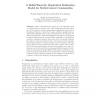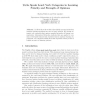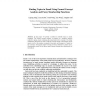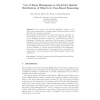AI
2008
Springer
13 years 6 months ago
2008
Springer
This paper presents a statistical model for discovering topical clusters of words in unstructured text. The model uses a hierarchical Bayesian structure and it is also able to iden...
AI
2008
Springer
13 years 11 months ago
2008
Springer
Modularization entails more efficient reasoning and better performance in the ontology manipulation process. Therefore, the development of modular ontologies has recently received ...
AI
2008
Springer
13 years 11 months ago
2008
Springer
Abstract. Conventional web search engines retrieve too many documents for the majority of the submitted queries; therefore, they possess a good recall, since there are far more pag...
AI
2008
Springer
13 years 11 months ago
2008
Springer
Online communities have grown to be an alternative form of communication for many people. This widespread growth and influence of the members of these communities in shaping the d...
AI
2008
Springer
13 years 11 months ago
2008
Springer
In this work we show that verbs reliably represent texts when machine learning algorithms are used to learn opinions. We identify semantic verb categories that capture essential pr...
AI
2008
Springer
13 years 11 months ago
2008
Springer
In this paper, we present a method to identify topics in email messages. The formal concept analysis is adopted as a semantic analysis method to group emails containing the same ke...
AI
2008
Springer
13 years 11 months ago
2008
Springer
Abstract. In the context of the RoboCup Simulation League, we describe a new representation of a software agent’s visual perception (“scene”), well suited for case-based reas...
AI
2008
Springer
13 years 11 months ago
2008
Springer
Alert correlation systems are post-processing modules that enable intrusion analysts to find important alerts and filter false positives efficiently from the output of Intrusion...





